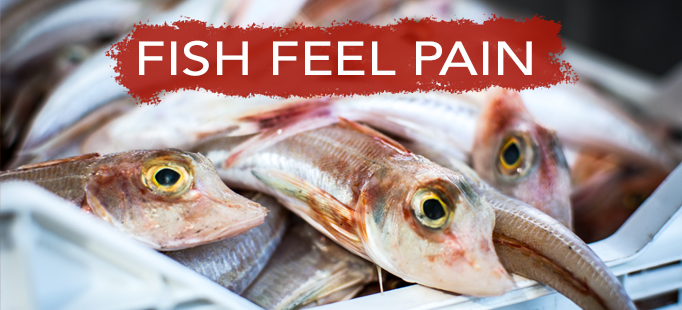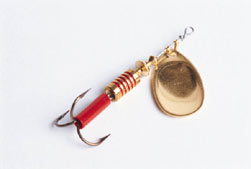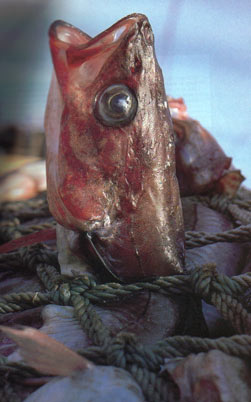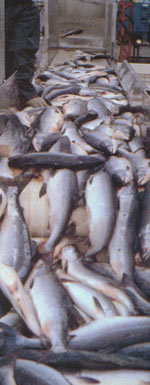
Fishing
The commercial fishing industry catches fish in the following ways:
Drift nets are nylon nets that hang suspended in the water for miles. Fish become trapped by their gills, as do other marine animals who, unable to reach the surface, drown.
Trawlers drag gigantic nets through the water, forcing fish into the closed end and vacuuming up sea life. The fish remain in the nets for hours, thrown against the rocks and debris that were also caught by the trawler. This rough, bumpy contact with inanimate objects and other fish sometimes files away the fishes’ scales. In the process, trawlers dump thousands of plastic containers and millions of pounds of packing material and plastic fishing net into the ocean.
Bottom Trawls are bag-shaped nets trawled over the seabed to catch fish living at the bottom of the ocean. The nets inadvertently catch all of the other species dwelling on the sea floor as well as the plants, therein destroying the habitat and sediment.
Purse seine consists of a net drawn up and closed like a bag; it is typically pulled behind a boat. Many dolphins have been caught and drowned by fisherman purse seining for yellowfin tuna.  Credit: DGLDuring long-lining, a ship unreels many miles of fishing line with thousands of razor-sharp baited hooks. The hooks are later ripped out of the fish’s mouths, which contain numerous pain receptors.
Credit: DGLDuring long-lining, a ship unreels many miles of fishing line with thousands of razor-sharp baited hooks. The hooks are later ripped out of the fish’s mouths, which contain numerous pain receptors.
Fishers may also employ electronic equipment and satellite communications to track fish.
Gillnets are also used to catch fish. The plastic, weighted nets hang many miles below the water's surface and fish, unable to see them, swim into the netting. Many get caught in the netting and suffocate or bleed to death trying to escape. Others may suffer for days because gillnets are not monitored.
Death
The intense pressure of decompression that the fish experience when dragged from the deep ruptures their swim bladder, pops out their eyes, and pushes their esophagus and stomach out through their mouth. Smaller fish like flounder are typically dumped onto chopped ice; most suffocate or are crushed to death by the fish that are thrown on top of them; others are gutted alive. Those better able to survive out of water may be filleted alive.
 Credit: Animals-VoiLarger fish like cod and haddock are sometimes thrown on the deck to be sorted. There, crewmembers stab the fish with short, spike rods called “pickers.” The fishes’ throats and bellies are then slit.
Credit: Animals-VoiLarger fish like cod and haddock are sometimes thrown on the deck to be sorted. There, crewmembers stab the fish with short, spike rods called “pickers.” The fishes’ throats and bellies are then slit.
Aquaculture: Fish Farms
Most of the trout and catfish and a large percentage of the salmon and mollusks, among other fish commonly consumed in America, are raised in fish factories. Far-removed from nature, they spend most of their lives in steel buildings. The fish are crowded into shallow, concrete troughs so tightly that infection and parasites are common. They can barely exercise, and they develop little muscle tissue. Their natural habitats and instincts are frustrated and, as a result of the stress, they engage in continual leaping
Like their farm animal counterparts, factory-farmed fish suffer disease, injuries, and stress as a result of the overcrowding. For one, injuries to the snout and fins are common as a result of the rubbing against net or collision or aggression between fish. This aggression is intensified by the fact that fish grow at different rates. Confining them so closely drives the animals to bully others, tail nipping, fin nipping, and even cannibalism.
The confinement also inhibits their migratory reflexes. In the wild, fish such as salmon gradually migrate from fresh water to salt water. The forced, abrupt transition on fish farms traumatizes the fish to such an extent that many of them die.
Furthermore, high-tech aquafarm systems control food, light, and growth stimulation.
To combat diseases like bacterial gill disease and infectious pancreatic necrosis, and accelerate growth and reproduction, the fish are given antibiotics and chemicals. Those antibiotics combine with growth hormones and genetic engineering to accelerate growth and increase weight. Genetic manipulation of other species such as pigs, cows, and chickens has produced painful side effects. We thus might expect fish, who have similar central nervous systems, to be experiencing the same
Stripping is the process whereby eggs are taken from female fish and sperm is taken from male fish on aquafarms. Both are normally killed at the end of the procedure.
Grading involves sorting fish of different sizes. The fish are starved for at least 12 hours beforehand and are usually put through a sorting machine. It is an extremely stressful process that causes them to panic and tries to escape. Some are injured and even killed.
Aquafarm Slaughter
 Credit: Animals-VoiceFarmed fish are deprived of food for days or weeks before slaughter to reduce the waste contamination of the water during transport. They may be removed from the water and placed on ice or the water may be drained so that they slowly suffocate. Alternatively, farmed fish may be electrocuted in a large tank or killed by a blow to the head.
Credit: Animals-VoiceFarmed fish are deprived of food for days or weeks before slaughter to reduce the waste contamination of the water during transport. They may be removed from the water and placed on ice or the water may be drained so that they slowly suffocate. Alternatively, farmed fish may be electrocuted in a large tank or killed by a blow to the head.
Some farmed fish are alive when their gill arches are cut, causing them to bleed to death while convulsing in pain. The fish may or may not be stunned in a tank with carbon dioxide gas beforehand. Either way, the fish experience great distress and try to escape.
Farmed fish may also die from toxic algal blooms and oxygen starvation in hot weather. Finally, some simply succumb to overcrowding, stress, and the excrement and urea build-up in the water.
Aquafarms and the Environment
Aquafarms are typically situated on coastal land cleared of mangrove forests, which are prime breeding and spawning ground for many fish. About half of the mangrove forests in the world have been cleared, drained, diked or filled. Moreover, aquafarms discharge waste, pesticides, and other chemicals into coastal waters, destroying ecosystems. Raising one ton of fish on an aquafarm, for instance, takes eight tons of water and produces an enormous amount of waste.
Aquafarms sometimes raise fish in fenced-in areas of natural waters, inevitably overloading natural habitats. The waste from the farms can cause thick layers of slime on the water’s surface, depleting oxygen and killing ocean life underneath. Additionally, chemicals like Dichlorvos, which is highly toxic to all forms of marine life including fish, are used as disinfectants for farm equipment. This toxicity, combined with the build-up from toxic by-products, has a highly detrimental effect on natural organisms and can destabilize the entire ecosystem.
"Sport" Fishing
“Sport" fishing typically involves fishing with a rod and reel, but may also include the use of bows and arrows, small nets, spears, and even guns. Anglers sometimes practice live baiting, in which a live small fish is threaded (often through the eye socket) as bait for a larger fish. “Sport" fishing is also harmful to the environment. Vegetation is often cut down or trampled to make the waterside more accessible to anglers. Moreover, the presence of anglers disturbs wildlife, especially during breeding periods. Birds and mammals, for instance, are typically frightened by the noise and movement associated with fishing.
Pollution
The following are frequently found in spots frequented by anglers:
- Discarded bait containers
- Groundbait
- Fishing lines
- Lunch tins
- Food and drink containers
- Polythene bags
Pain
Fish have a brain, a central nervous system, and pain receptors. More specifically, they have the same nerve endings, chemicals for transmitting and blocking pain, and the same receptor sites for anxiety-reducing chemicals as mammals. Like other vertebrates, fish have a highly developed system that releases enkephalins and endorphins when they are injured. The presence of this pain-killing system suggests an innate capacity to feel pain. Put simply, all of the structures and processes necessary to feel pain are present in fish.
Fish first feel pain when the hook pierces their mouth and they are reeled in. They gasp, writhe, flap their gills, and struggle when caught. Most fish that produce sound vocalize when they are held, prodded, or chased. They cry out in pain and fear. Experiments show that fish learn to avoid pain, even depriving themselves of food for extended periods of time in order to do so.
Catch and Release
Hooking a fish is a cruel and unnecessary activity. Fish begin to suffocate as soon as they are removed from their environment. Their blood coagulates, their gills often bleed and collapse, and their swim bladder may also rupture due to the pressure change. Fish may die from the stress of being caught, or they may be so weakened by the experience that they easily fall prey to predators. More specifically, the fish’s struggle to survive may cause a buildup of lactic acid in their muscles, causing stiffness and soreness and thus hampering the animal’s ability to survive. This damage may also include oxygen depletion, the loss of their protective outer coating, and damage to their delicate fins and mouth. Many fish caught in catch-and-release fishing tournaments die later as a result of their injuries, especially in hot weather when water oxygen levels are low.
Overfishing
Overfishing occurs when fish are caught at a faster rate than they naturally reproduce. The population of nearly one-third of all fish species has declined in the last 15 years. All 17 of the world’s major fisheries have either reached or exceeded their limits. Many species of fish have been wiped out or critically endangered by commercial fishing alone, yet the government continues to subsidize the industry.
Overfishing affects not only target fish but other animals in the ecosystem including non-target fish, birds such as penguins, marine mammals, and smaller organisms that depend on fish to survive. Because some species have been overfished, fishers have switched to other species lower in the food web, therein robbing larger fish, marine mammals, and seabirds of food. And because these “lower” fish earn fishermen less money, they must catch more of them to sustain their income. Overfishing has also rendered some fish less able to survive. For instance, many fish species have been unable to cope with environmental changes such as El Niño because they were already under extreme pressure from the fishing industry.
Bycatch
Bycatch is a non-target catch. Much marine catch is thrown back into the water because it is too small or not the species fishermen were searching for. Bycatch may include non-target fish species; juvenile fish; animals of no commercial value such as urchins; birds; turtles; and marine mammals like seals and dolphins. Tuna fishermen, for instance, still ensnare and kill thousands of sharks, turtles, and billfish (e.g. swordfish). The unwanted animals are typically thrown back into the sea dead or injured, or so weakened that they will easily be killed by predators.
Threat to Wildlife
Every year, approximately 100,000 seals, whales, and porpoises become entangled in fishing nets and fishing line and drown. At least 20,000 dolphins, who naturally swim with yellowfin tuna, drown annually in fishing nets meant for the latter. Thousands of sea turtles are also inadvertently killed by nets meant to catch shrimp. Millions of birds suffer the same fate. Most tackle victims are never found; instead, they suffer slow, agonizing deaths
The feet, beaks, and throats of other birds, particularly swans and ducks, frequently become hooked or torn by fishing hooks and lures, often causing fatal injuries including severed wings or feet. Countless birds also die after swallowing fishhooks, as do many turtles, bats, and other animals. Otters, for instance, may swallow so much plastic fishing lure that they can no longer digest their d. Pets and livestock are also affected.
Some fisherman purposely kill or maim wildlife, including seals, otters, herons, cormorants, birds, and marine mammals, who they perceive to be a threat to their catch. They may shoot, trap, or deliberately entangle the animals, or they may call for these animals to be culled. Culling is especially damaging to endangered species like otters and voles who depend on watersides. Aquafarmers may also harm fish-eating birds, who are naturally drawn to aquaculture ponds. Many aquafarmers kill the birds, even though they could instead use a non-lethal repellant.
The fishing industry poses a further threat to wild fish populations when farmed fish escape. Thousands regularly break free of cages that have been damaged by storms and the like. When the farmed fish interbreed with wild fish, their offspring are generally less able to survive. The farmed fish may also destroy indigenous species by creating additional competition for food and by introducing parasitic infections into native populations.
Human Health
Not only are there naturally occurring toxins in fish and shellfish, but the former can accumulate high levels of chemical residue. In other words, pollutants like mercury, lead, and pesticides can concentrate in sea creatures. Fish flesh may store contaminants such as PCBs, dioxins, radioactive substances, and toxic metals, which can cause health problems in humans.
Commercial fish are taken from a sea deluged with industrial waste, chemicals, and sewage sludge. The latter contains human pathogens that may contaminate fish and pass pathogens on to fish-eating consumers. Scavenger fish such as pike often contain salmonella bacteria.
Pollutants may build up in farmed fish as well, due to the industry, agriculture, and sewage located on the coasts or bays where most aquafarms are located. In addition, farmed fish are regularly given antibiotics, which can result in an increase in antibiotic-resistant bacteria. This bacteria can also be passed on to fish-eating humans.
What's more, fish lack the antioxidants and fiber found only in plant-based foods and consuming them can cause food allergies.
How Going Vegan Helps Fish
Vegans do not consume animals or animal products. Many abstain from doing so due to the horrendous treatment of animals on modern day factory farms which produce the vast majority of the meat and poultry consumed in the U.S. The factory farming of animals, including fish and livestock, cause land degradation, soil erosion, and water pollution. The fertilizers, manures, and sediments associated with raising animals for food yield pollutants that routinely find their way into streams, lakes, rivers, creeks, and oceans. The pollution and the stress and chemicals that accompany it inevitably harm fish populations. For instance, agricultural pollutants smother fish eggs and block sunlight, thus killing the aquatic plants that provide cover for fish and the organisms they feed on. The nutrient overloading from animal (and human) waste has killed millions of fish. Sadly, the fish do not even have to come close to the shore to be sickened or killed by this agricultural runoff.
What You Can Do:
- Go vegan! Do not eat fish or other animals and abstain from consuming or using animal products. Read our page on veganism for more information.
- Don’t litter! Help keep rivers, beaches, bays, and other coastal waters clean and safe.
- Help protect birds, fish, and other animals by removing fishing line and other tackle.
- Ask local officials to ban fishing at a pond or lake in your area.
- Demand that your government stops subsidizing fishing operations with your tax dollars.
- Ask the U.S. government to ban fishing in national parks. Click here to contact the National Park Service
- Distribute information on the cruelty of fishing outside of bait-and-tackle stores or in popular fishing spots.
- Protest fishing tournaments and other fishing events.
- Encourage fish farmers to use non-lethal methods of wildlife control such as predator-proofing farms (with top nets), displacement, or a visual or audible device instead of through trapping, shooting, or entanglement.
- Educate your family and friends about the cruel reality of fishing.